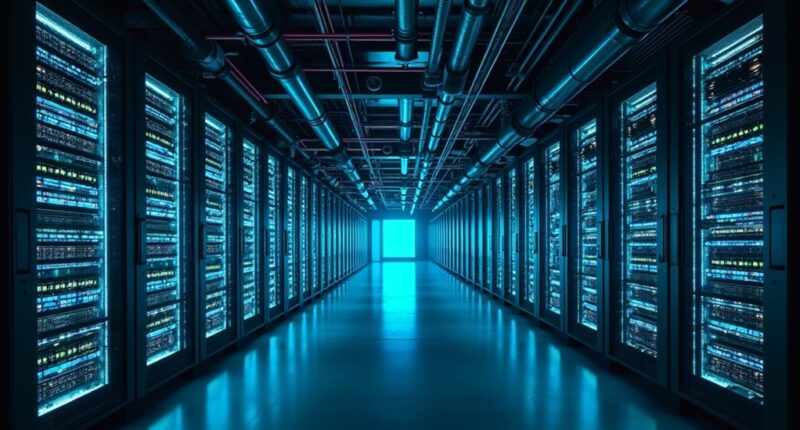AI workloads are rapidly increasing U.S. electricity demand, with projections reaching up to 580 TWh by 2028. Data centers and AI training require massive energy, straining the electric grid and risking shortages. Concentration in regions like Northern Virginia worsens capacity issues. Despite efforts to improve efficiency, the pace of AI growth threatens to overwhelm infrastructure. Stay tuned—there’s more to understand about how this surge could impact America’s power supply.
Key Takeaways
- AI workloads are projected to consume up to 12% of U.S. electricity by 2028, straining the electrical grid.
- Large-scale AI training requires massive, energy-intensive hardware, increasing overall electricity demand significantly.
- Concentration of AI data centers in limited regions causes local grid bottlenecks and operational risks.
- Rapid AI growth outpaces capacity expansion efforts, risking overloads and outages in existing electrical infrastructure.
- Despite efficiency improvements, AI’s expanding energy needs threaten to overwhelm current U.S. power systems.

Have you ever wondered how artificial intelligence is shaping the demand for electricity in the United States? The rapid growth of AI workloads is substantially impacting the country’s energy landscape. In 2023, U.S. data centers consumed about 4.4% of total electricity—roughly 176 terawatt-hours (TWh). But this is just the beginning. Experts project AI-related electricity demand to skyrocket to between 325 and 580 TWh by 2028, potentially accounting for up to 12% of the nation’s total electricity generation. That growth rate is staggering, increasing at about 30% annually worldwide, with the U.S. and China responsible for 80% of this surge. As AI becomes more embedded in industries, the overall U.S. electricity consumption is expected to grow, driven largely by expanding data centers and commercial sector needs. The U.S. Energy Information Administration predicts total electricity use will reach around 4,283 billion kWh by 2026, with data centers and AI infrastructure contributing a significant portion of this rise. This rapid expansion means that electricity demand in the commercial sector, including AI data centers, could grow at an average rate of 5% annually through that period.
AI-driven data centers in the U.S. may increase electricity demand by up to 12% by 2028, stressing the national grid.
You might not realize how intense the resource demands are for training large AI models. These models require thousands of GPUs and specialized hardware, running continuously for weeks or even months. Such operations demand massive amounts of electricity, not only for computation but also for cooling and infrastructure support. The process involves high-performance computing infrastructure—GPUs, TPUs, CPUs—working in parallel, which results in enormous energy consumption. With AI models constantly retrained to stay relevant, the cumulative energy use keeps climbing. Only big tech organizations can shoulder the costs and infrastructure needed for training these massive models, which include generative models like GPT-4. As models grow more complex and data-intensive, the energy demands of data centers increase exponentially. This growth in power consumption could lead to significant strain on existing electrical grids, especially during peak training periods. Moreover, the 16PF questionnaire can help organizations identify personality traits that may influence energy-saving behaviors in the workplace.
The geographic concentration of AI infrastructure compounds these challenges. Regions like Northern Virginia, the largest U.S. data center hub, are experiencing delays due to surging electricity demand and infrastructure constraints. Most AI data centers are clustered in specific areas, putting localized pressure on grids and causing bottlenecks. Power consumption in these centers far exceeds the capacity expansion rate, often outpacing it by four times, forcing grid operators to scramble for solutions. Despite improvements in overall efficiency, local grids struggle to keep up with AI-driven demand. This creates operational risks and supply bottlenecks, especially in regions heavily reliant on AI infrastructure.
While efficiency efforts are underway—such as better power usage effectiveness (PUE), innovative hardware, and smarter training methods—the challenge remains substantial. Data centers are adopting energy-efficient hardware and exploring ways to reduce training energy needs. Still, the rapid pace of AI growth threatens to strain the U.S. electrical system unless bold, coordinated actions are taken to expand capacity and improve grid resilience.
Frequently Asked Questions
How Can Renewable Energy Mitigate Ai’s Electricity Demand?
Renewable energy can help mitigate AI’s electricity demand by providing a clean, sustainable power source that reduces reliance on fossil fuels. You can source electricity directly from wind, solar, or hydro, or enter into power purchase agreements to secure green energy. AI also optimizes energy consumption patterns, aligning usage with renewable availability, which minimizes peak loads and supports a more resilient, environmentally friendly grid capable of meeting AI’s increasing demands.
What Policies Are in Place to Regulate AI Energy Consumption?
You won’t find any strict federal rules regulating AI energy use. The government prefers to fast-track permits and deregulate environmental standards, hoping AI’s power demands won’t overrun the grid. Industry self-regulates with voluntary efficiency measures, while policies mainly focus on infrastructure expansion rather than conservation. So, while AI’s energy consumption skyrockets, you’re left to hope that tech companies and deregulation will somehow keep the lights on.
How Does Ai’s Energy Use Compare Globally?
You see that AI’s energy use varies globally, with the U.S. leading due to its large AI investments and infrastructure. China is catching up quickly, while other regions depend on their energy sources and policies. Overall, AI data centers could consume up to 20% of global electricity by 2035, mainly from fossil fuels, which raises environmental concerns. This uneven distribution impacts global efforts to reduce carbon emissions and manage energy resources effectively.
Are There Energy-Efficient AI Development Practices?
Ironically, the best way to make AI greener is to develop it smarter. You can save energy by using early stopping to avoid unnecessary training, choosing smaller, domain-specific models, and leveraging transfer learning. Hardware improvements like GPUs and specialized chips also help. Additionally, optimizing software and data center operations, plus adopting policies for renewable energy, makes your AI development more sustainable without sacrificing progress.
What Is the Long-Term Impact of AI on Grid Stability?
Long-term, AI can both challenge and strengthen grid stability. While AI-driven data centers increase electricity demand, AI also enhances grid management through improved forecasting, real-time monitoring, and self-healing capabilities. If managed properly, AI will help prevent outages, optimize renewable integration, and maintain resilience. However, without proper standards and infrastructure upgrades, the rising AI workload could strain the grid and create vulnerabilities over time.
Conclusion
As you consider the growing AI workloads, it’s clear they could strain America’s electrical grid. With AI data centers consuming up to 1,000 times more energy than traditional servers, the challenge becomes even more urgent. If current trends continue, the demand might outpace existing capacity, risking outages or increased costs. Staying ahead means investing in smarter energy solutions now, so you can support innovation without jeopardizing the stability of the power grid.









